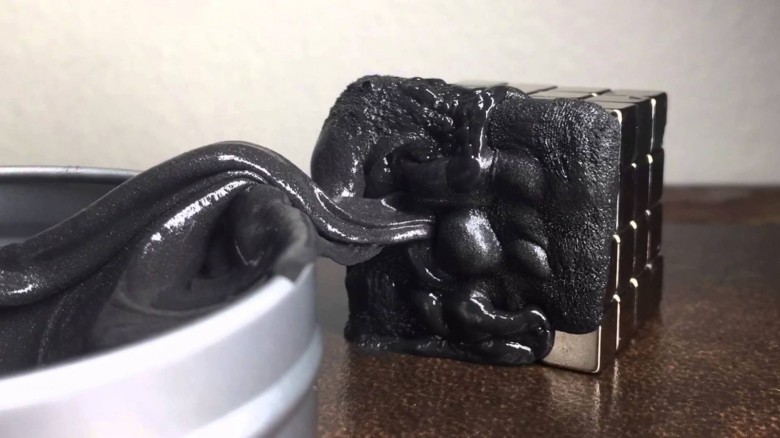Magnetic putty (also known as silly putty) is stretchable, moldable putty that contains particles whose magnetic poles line up in the presence of a magnetic metal and is a silicone polymer children's toy. Because it is pliable, it will fully encompass any metal object placed near it. Like any other putty, it can be stretched, bounced, molded, popped, and torn. However, when this putty is in the presence of a magnetic field, it exhibits fascinating properties. Silly putty is fun because it has some unique properties: it is viscoelastic, meaning it can be stretched and shaped and mashed back together again; and as its apparent viscosity increases directly with respect to the amount of force applied (read: it can be torn or shattered with impact). Silly putty is a non-Newtonian viscoelastic polymer, better characterized as a dilatant fluid.
Materials and method
Millions of tiny micron-sized magnets are embedded in each handful of Magnetic Thinking Putty. Made with micron-sized iron-based particles distributed throughout, the astonishing moldable magnetic putty takes on the properties of a magnet itself when placed in close contact with the included Neodymium Iron Boron magnet. By adding a ferrous component to an already wacky toy we can keep all characteristics of the original putty, but now have the additional dimension of magnetism. We can make our own magnetic putty for a fraction of the price and in small time. To create the magnetic putty, you mix the iron oxide with the putty at about one teaspoon per 0.8 oz size “egg” of putty. Black iron oxide, like all kinds of fine metal powders, is nasty business, so you’ll want to wear gloves and a dust mask when handling it. The black iron will also stain, and the resulting putty might stain, too, so be mindful of what surface you use it on. And best to keep it in an airtight bag or tin when not using it.
|
Tools: · disposable gloves (latex or other) · disposable face mask · disposable work area (paper plate) |
Materials: · Thinking Putty (any colour)
· black iron oxide powder · neodymium magnet |
The secret ingredient that makes the putty magnetic is an iron oxide powder, which is ferric (magnetic). Ferric iron oxide is a fine powder used as black pigment and can be found at art stores.
Fun with putty
Magnetic Thinking Putty is really mesmerizing stuff. Each tin contains millions of micron-sized micromagnets embedded into the Thinking Putty. Ferromagnetic particles in the putty are strongly attracted to the magnet and very slowly engulf the surface of the magnet. The presence of the strong neodymium iron boron magnet magnetizes the ferromagnetic particles in the putty. When this happens, the ferrous particles align with each other and this alignment generates north and south magnetic poles, making the putty into a temporary magnet. Once magnetized, the putty will remain magnetized even after the rare-earth magnet has been removed from the putty. They are just waiting for the chance to strut their stuff. It's perfect for science-loving kids, or for any adult that loves intelligent play. What can you do with it? The possibilities are endless.
· Use the included super-strong ceramic magnet to control the putty like a snake charmer.
· Or leave the magnet on your ball of putty and watch it engulf that magnet in about an hour
· Or "charge" the blob of putty so it can become a magnet of its own and pick up small tacks and paperclips.
· Put it near the magnet and within five seconds, the putty will stretch itself out to reach the magnet almost as if it were alive.
· Press the magnet into it and the whole piece of putty becomes magnetic, able to lift tacks and paperclips on its own after charging in a magnetic field.
Precautions
Neodymium magnets are extremely strong: Fingers can easily get pinched when trying to separate the magnets, so we didn’t even separate ours. Be sure to keep the magnets away from cell phones, computer, and other electronics. Also make sure that no one puts them in their mouth – these would be very dangerous if swallowed. Overall, this is not a project for kids who still put things in their mouths.
Iron oxide powder is not good to breathe: This is why we mixed our iron in with the liquid starch. It is recommended to mix the iron powder directly into ready-made silly putty. Working with the iron powder is messier than just stirring it into a liquid and you may have trouble getting it to mix with the silly putty.
